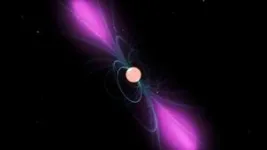(Press-News.org)
The Universe teems with extreme environments, ranging from the very coldest temperatures to the highest energy sources possible. As a consequence, extreme objects such as supernova remnants, pulsars and active galactic nuclei are capable of emitting charged particles and gamma rays with incredibly high energies, so high that they exceed the energy produced by the nuclear fusion in stars by several orders of magnitude.
The gamma rays detected on Earth tell us a great deal about these sources, since they travel through space undisturbed. However, in the case of charged particles, also known as cosmic rays, things are more complicated because they are constantly buffeted by the magnetic fields present everywhere in the Universe, and impact the Earth isotropically, in other words from all directions. What's more, these charged particles lose some of their energy along the way, when they interact with light and magnetic fields. These energy losses are especially significant for the most energetic electrons and positrons, known as cosmic-ray electrons (CRe), whose energy exceeds one teraelectronvolt (TeV) (i.e. 1000 billion times greater than that of visible light)1. It is therefore impossible to determine the point of origin of such charged particles in space, although their detection on Earth is a clear indicator that there are powerful cosmic-ray particle accelerators in its vicinity.
However, detecting electrons and positrons with energies of several teraelectronvolts is particularly challenging. Space-based instruments, with detection areas of around one square metre, are unable to capture sufficient numbers of such particles, which become increasingly rare the higher their energy. Ground-based instruments on the other hand, which indirectly detect the arrival of cosmic rays via the showers of particles they produce in the Earth's atmosphere, are faced with the challenge of differentiating the showers triggered by cosmic-ray electrons (or positrons) from the much more frequent showers produced by the impact of the heavier cosmic-ray protons and nuclei. The H.E.S.S. Observatory2 located in Namibia uses five large telescopes to capture and record the faint Cherenkov radiation produced by the heavily charged particles and photons that enter the Earth's atmosphere, producing a shower of particles in their wake. Although the Observatory’s main purpose is to detect and select gamma rays in order to investigate their sources, the data can also be used to search for cosmic-ray electrons.
In the most extensive analysis ever carried out, H.E.S.S. collaboration scientists have now obtained new information about the origin of these particles. The astrophysicists did this by combing through the huge data set collected over the course of a decade by the four 12-metre telescopes, applying new, more powerful selection algorithms capable of extracting the CRe from the background noise with unprecedented efficiency. This resulted in an unrivalled set of statistical data for the analysis of cosmic-ray electrons. More specifically, the H.E.S.S. researchers were able to obtain for the first time data about CRe in the highest energy ranges, all the way up to 40 TeV. This enabled them to identify a surprisingly sharp break in the energy distribution of the cosmic-ray electrons.
“This is an important result, as we can conclude that the measured CRe most likely originate from very few sources in the vicinity of our own solar system, up to a maximum of a few 1000 light years away, a very small distance compared to the size of our Galaxy”, explains Kathrin Egberts, from the University of Potsdam, one of the corresponding authors of the study.
“We were able to put severe constrains on the origin of these cosmic electrons with our detailed analysis for the first time”, adds Prof. Hofmann from the Max-Planck-Institut für Kernphysik, co-author of the study. “The very low fluxes at larger TeV limit the possibilities of space-based missions to compete with this measurement. Thereby, our measurement does not only provide data in a crucial and previously unexplored energy range, impacting our understanding of the local neighbourhood, but it is also likely to remain a benchmark for the coming years”, Mathieu de Naurois, CNRS Researcher from the Laboratoire Leprince-Ringuet, adds.
Footnotes :
1 TeV = 1012 electronvolts.
High-energy gamma rays can be observed from the ground only because of a very specific phenomenon. When a gamma ray enters the atmosphere it collides with its atoms and molecules, producing new particles that sweep towards the ground rather like an avalanche. The particles emit flashes lasting mere billionths of a second (Cherenkov radiation), which can be observed using large, specially equipped ground-based telescopes. The H.E.S.S. Observatory, located in the Khomas Highlands of Namibia at an altitude of 1835 m, officially began operation in 2002. It comprises an array of five telescopes. Four telescopes with mirrors 12 m in diameter are located at the corners of a square, with another 28 m telescope at the centre. This makes it possible to detect cosmic gamma rays ranging from a few tens of gigaelectronvolts (GeV, 109 electronvolts) to a few tens of teraelectronvolts (TeV, 1012 electronvolts). By comparison, photons of visible light have an energy of two to three electronvolts. H.E.S.S. is currently the only instrument observing the southern sky in high-energy gamma-ray light. It is also the largest and most sensitive telescope system of its kind. END
COLUMBUS, Ohio – An international team of researchers has made new observations of an unusual supernova, finding the most metal-poor stellar explosion ever observed.
This rare supernova, called 2023ufx, originated from the core collapse of a red supergiant star, exploded on the outskirts of a nearby dwarf galaxy. Results of the study showed that observations of both this supernova and the galaxy it was discovered in are of low metallicity, meaning they lack an abundance of elements heavier than hydrogen or helium.
Since the metals produced within supernovae ...
About The Study: The findings of this study suggest that women who experience severe maternal morbidity in their first birth are less likely to have a subsequent birth. Adequate reproductive counseling and enhancing antenatal care are crucial for women with a history of severe maternal morbidity.
Corresponding Author: To contact the corresponding author, Eleni Tsamantioti, MD, MMedSc, email eleni.tsamantioti@ki.se.
To access the embargoed study: Visit our For The Media website at this link https://media.jamanetwork.com/
(doi:10.1001/jama.2024.20957)
Editor’s ...
Armenians, a population in Western Asia historically inhabiting the Armenian highlands, were long believed to be descendants of Phrygian settlers from the Balkans. This theory originated largely from the accounts of the Greek historian Herodotus, who observed that Armenians were armed in Phrygian fashion when serving in the Persian army. Linguists further supported this theory, suggesting that the Armenian language shares ties with the Thraco-Phrygian subgroup of Indo-European languages.
But the first whole-genome study is challenging this long-held belief, revealing no significant genetic link between ...
Women who suffer severe complications during their first pregnancy or delivery are less inclined to have more babies, a study published in JAMA by researchers at Karolinska Institutet reports. Given the recent steady decline in birth rate in Sweden, the researchers propose monitoring in antenatal care to address the problem.
“The clinical monitoring of these women is essential, and they need individualised advice on possible future pregnancies,” says the study’s first author Eleni Tsamantioti, doctoral student at the Department of Medicine in Solna, Karolinska Institutet.
Birth rates and fertility have both been in steady decline ...
CHAPEL HILL, North Carolina—Colorectal cancer screening is an effective tool for catching the disease early when it's most treatable, yet it is underutilized in patient populations who receive primary care at federally qualified health centers (FQHC).
A new study by researchers at UNC Lineberger Comprehensive Cancer Center demonstrated that a targeted intervention can substantially increase screening rates in patients who are not current with recommended screening. The researchers report in JAMA Network Open that mailing at-home ...
About The Study: No unexpected reactions were identified in this analysis of reactions to COVID-19 vaccines among children. Similar to this study, data from clinical trials and V-safe found that irritability was the most common systemic reaction among children ages 6 months to younger than 2 years, followed by fever and fatigue or sleepiness. In contrast to other studies observing a higher prevalence of reactions after the second COVID-19 vaccine dose, this study observed a higher prevalence after the first dose. This difference may reflect maternal vaccination; the ...
About The Study: This study estimates that approximately one-third of U.S. adults without diabetes who were eligible for weight loss treatment with glucagon-like peptide 1 (GLP-1) and glucose-dependent insulinotropic polypeptide (GLP-1/GIP) were excluded from clinical trials supporting these medications’ safety and effectiveness. Until there is evidence from high-quality postmarketing studies, the FDA should consider updating labeling to advise caution on generalizing the safety and effectiveness of GLP-1 and GLP-1/GIP to populations excluded from pivotal trials.
Corresponding Author: To contact the corresponding author, Timothy S. Anderson, MD, MAS, email tsander@pitt.edu.
To ...
About The Study: In this cohort study, after adjusting for measured confounders, long-term exposure to wildfire and non-wildfire fine particulate matter (PM2.5) over a 3-year period was associated with dementia diagnoses. As the climate changes, interventions focused on reducing wildfire PM2.5 exposure may reduce dementia diagnoses and related inequities.
Corresponding Author: To contact the corresponding author, Joan A. Casey, PhD, email jacasey@uw.edu.
To access the embargoed study: Visit our For ...
Researchers from the National Institute of Health Data Science at Peking University have conducted a comprehensive review of the health impacts of China's carbon mitigation strategies. Published in Health Data Science, this review emphasizes the significant health co-benefits of environmental policies aimed at reducing greenhouse gas emissions in China, the world's largest carbon emitter. These benefits include reducing deaths and diseases related to air pollution, particularly from PM2.5 and ozone (O3), as well as mitigating climate-related ...
A team from the Champalimaud Foundation (CF) has pinpointed a critical neural circuit for sexual rejection, identifying a set of brain cells that play a crucial role in determining whether a female accepts or rejects mating attempts based on her reproductive cycle. Their findings, published today in Neuron, deepen our understanding of how the brain regulates social and reproductive behaviours.
Female mammals, such as rodents, accept mating attempts only during their fertile phase, and actively reject males outside this period. While the brain areas controlling sexual receptivity are well-studied, the mechanisms behind active rejection ...



